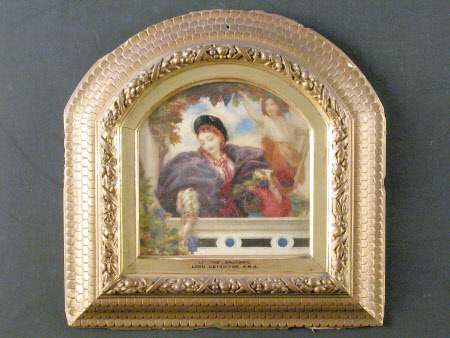At the Balcony
Sir Frederic Leighton, Lord Leighton PRA (Scarborough 1830 – Kensington 1896)
Category
Art / Drawings and watercolours
Date
circa 1859
Materials
Watercolour on paper
Measurements
121 x 118 cm
Order this imageCollection
Wightwick Manor, West Midlands
NT 1287890
Summary
Watercolour and varnish on paper (segmental-arched top), At the Balcony by Sir Frederic Leighton, Lord Leighton PRA (Scarborough 1830 – Kensington 1896), circa 1859 .A watercolour of lady in period costume reaching out over balcony to pick grapes. In the background a young girl on a ladder reaches into vines.
Full description
Leighton was one of the leading Victorian classical painters. Born in Scarborough, he had a cosmopolitan upbringing after his father inherited a fortune in 1841 and gave up his medical practice to travel around Europe with his family. In 1846 he began his artistic training in Frankfurt, where he exhibited for the first time in 1850. From 1852 he studied and worked in Italy. His first major picture to be exhibited at the Royal Academy in 1855, Cimabue's Celebrated Madonna Carried in Procession, was purchased by Queen Victoria. His early works have mediaevalising subjects and settings comparable to the Pre-Raphaelites, and Ruskin praised him as practicing Pre-Raphaelite principles. However, although on friendly terms with the Pre-Raphaelite artists Leighton was never closely involved with the movement. His work was predominantly figurative and naturalistic, without the intensity, symbolic detail and moral earnestness of the Pre-Raphaelites. Leighton moved to Paris in 1855, and had contacts with Barbizon School artists such as Corot and Millet. In 1858 he returned to Rome. He spent the summer of 1859 in the south of Italy, making studies in Capri and elsewhere of landscapes, buildings, gardens etc. in oils, pencil and watercolour as he strove to develop complete technical command of all the media. He settled in London in 1859, and in the 1860s developed his distinctive classical manner based on the European academic tradition, using classical subjects with an emphasis on the nude, carefully constructed composition, design and colour. Flaming June and The Garden of the Hesperides are among his most famous works. he was highly ambitious and immensely successful: he he became President of the Royal Academy and was knighted in 1878, was made a baronet in in 1886, and in 1896 was given a peerage under the title Lord Leighton of Stretton. This picture, with its figure in Italianate costume, lush vegetation and bright colour, probably derives from Leighton's Italian studies. It has no 'subject' in the sense of any kind of narrative or meaning.
Provenance
Agnew's; H.R. Barnes sale, Christie's 18 November 1921, lot 37, bought by Sampson, £24-3; Sotheby's 22 April 1959, lot 10, purchased by Sir Geoffrey Mander, £16; transferred to the National Trust on the death of Sir Geoffrey Le Mesurier Mander (1882-1962)
Marks and inscriptions
Thos Agnew label.
Makers and roles
Sir Frederic Leighton, Lord Leighton PRA (Scarborough 1830 – Kensington 1896), artist
